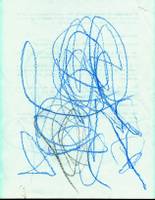
Really, it's a dog.

When prompted, she pointed out the tail, nose, and toes. If you squint you can kind of see it. That's a dog alright, its tail wagging up on the left, blobby mass of head to the right.
This morning, I conducted a little science experiment. I asked her about the picture. It's still a doggy, its tail, nose, and toes still in the same places.
Does she clearly "see" doggy in her handiwork? Or does she "merely" remember having proclaimed it a dog and want to stick by her story?
When artists paint with a "child-like naivete," do they physically behold the world differently? — Not filling in the blanks, as it were, as the rest of us are accustomed to doing to give continuity to our surroundings; nor grasping for details to help attribute meaning. The world is beheld just for a moment as it is.


3 comments:
It is quite clearly a dog. But then, I'm a cartoonist...
--rachel
It is very much a dog - a wonderful blue dog. How George Rodrigue of her! You must frame it and hang it with pride - it is art after all.
michele agnew
But would you recognize it as a dog if I hadn't told you what it was? It's so obvious to me now, but there was a point when it was just a mass of scribble. Will Helena see it in 5 or 10 years time and see the dog? Or maybe she'll remember having named it, and will look at it a moment longer before understanding why.
It's a weird example of that point in the creative process, where you decide what shape something will take, when art take on its meaning.
That's a lot to be reading into a toddler's drawing, eh? I'm off to play with some Lego now.
Post a Comment